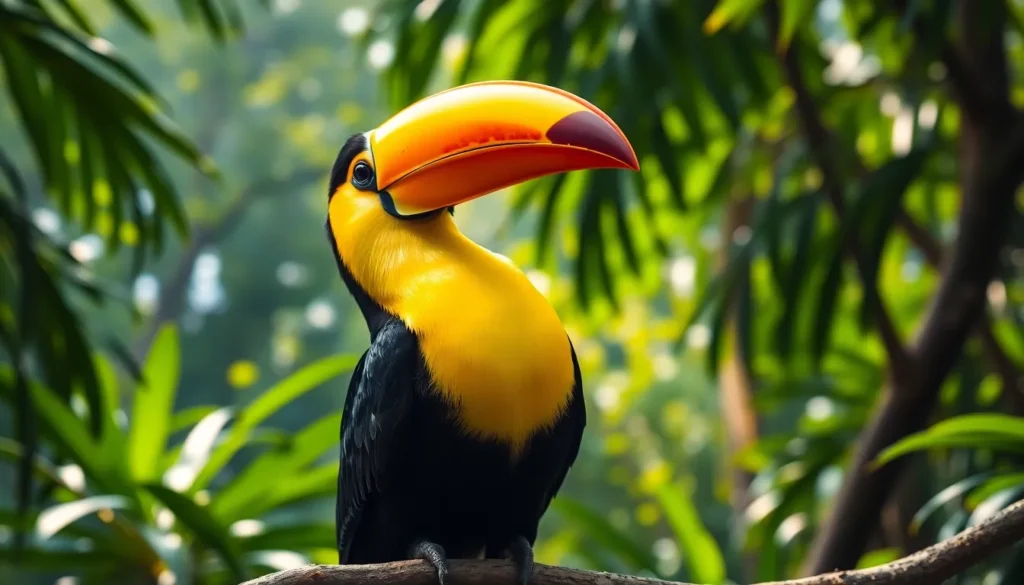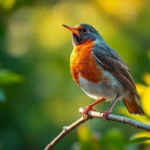We’ve all seen that iconic colorful beak in cartoons and cereal commercials but there’s so much more to discover about these remarkable tropical birds. Toucans aren’t just pretty faces – they’re fascinating creatures with unique adaptations that’ll blow your mind.
From their surprisingly lightweight beaks to their acrobatic sleeping positions these vibrant rainforest dwellers pack personality into every feather. We’re diving deep into the industry of toucans to uncover the secrets behind their stunning appearance and incredible survival skills.
Whether you’re a bird enthusiast or simply curious about nature’s most photogenic species you’ll be amazed by what these tropical treasures can teach us about adaptation and biodiversity. Let’s explore why toucans have captured our hearts and what makes them true marvels of the animal kingdom.
What Makes the Toucan Bird Unique
Toucans stand out from other birds through their extraordinary physical features and specialized adaptations. These remarkable creatures possess characteristics that make them instantly recognizable and perfectly suited for their rainforest environment.
Distinctive Physical Characteristics
Toucan birds display vibrant coloration patterns that vary dramatically across the 40 different species. Their bodies typically measure 12 to 24 inches in length, with the largest species like the Toco Toucan reaching weights of up to 1.5 pounds. Bright yellows, oranges, reds, blues, and greens dominate their feather patterns, creating striking contrasts that help with species recognition and communication.
| Physical Feature | Measurement | Function |
|---|
Body Length | 12-24 inches | Species identification
Weight | 4 ounces to 1.5 pounds | Flight efficiency
Tail Length | 6-10 inches | Balance during perching
Wing Span | 15-20 inches | Canopy navigation
Compact bodies and relatively short wings make toucans excellent perchers rather than long-distance flyers. Their zygodactyl feet feature two toes pointing forward and two backward, providing exceptional gripping strength on branches. Strong leg muscles support their unique sleeping position where they tuck their heads backward and fold their tails over their bodies.
Remarkable Beak Structure and Function
Toucan beaks represent one of nature’s most impressive engineering achievements, comprising up to one-third of the bird’s total body length. The beak structure consists of a lightweight honeycomb interior made of keratin, covered by a thin outer shell that weighs surprisingly little even though its massive appearance.
Blood vessels throughout the beak serve as natural air conditioning systems, helping toucans regulate their body temperature in tropical climates. Large surface area allows for efficient heat dissipation when temperatures rise above 85°F. The beak’s serrated edges function like built-in tools for grasping and manipulating food items including fruits, insects, and small reptiles.
Precision handling capabilities enable toucans to pluck fruits from branch tips that other birds cannot reach. Their beaks extend their feeding radius by 6 to 8 inches beyond their natural reach, giving them access to approximately 40% more food sources than birds with conventional bill structures. This specialized feeding adaptation allows toucans to consume over 100 different fruit species throughout their range.
Toucan Bird Species and Varieties

The toucan family encompasses 40 distinct species distributed across Central and South American rainforests. Each species showcases remarkable adaptations that reflect their exact environmental conditions and ecological roles.
Common Toucan Species
Toco Toucans dominate South American landscapes as the largest members of the toucan family. These birds measure up to 24 inches in length and display the most recognizable orange beaks with black tips. We find them throughout Argentina, Bolivia, Brazil, French Guiana, Guyana, Paraguay, Peru, Suriname, and Uruguay.
Keel-billed Toucans inhabit Central American rainforests from southern Mexico to northern Colombia. Their rainbow-colored beaks feature yellow, green, blue, red, and orange sections that create stunning visual displays. These medium-sized toucans reach lengths of 17 to 22 inches.
Channel-billed Toucans represent the largest toucan species in terms of body mass. We observe them across South American regions including the Amazon Basin. Their distinctive yellow throat patches and blue skin around the eyes distinguish them from other species.
Chestnut-mandibled Toucans occupy cloud forests and lowland rainforests from Honduras to northern Colombia. These birds feature prominent yellow bibs and chestnut-colored lower mandibles that give them their common name.
Size and Color Variations
Toucan species exhibit important size differences that range from compact 12-inch Lettered Aracaris to massive 24-inch Toco Toucans. Weight variations span from 4.6 ounces in smaller species to 1.5 pounds in the largest specimens.
| Species Category | Length Range | Weight Range | Primary Colors |
|---|---|---|---|
| Small Toucans | 12-16 inches | 4.6-8 ounces | Green, yellow, red bands |
| Medium Toucans | 17-20 inches | 9-14 ounces | Rainbow beaks, blue throats |
| Large Toucans | 21-24 inches | 15-24 ounces | Orange, black, white patterns |
Beak coloration varies dramatically between species and serves multiple identification purposes. Toco Toucans display solid orange beaks while Keel-billed Toucans showcase rainbow patterns. Green-billed Toucans feature predominantly green coloration with yellow accents.
Body plumage patterns create distinct species signatures across toucan varieties. Black dominates most species’ backs and wings while breast colors range from bright yellow in Chestnut-mandibled Toucans to white in Toco Toucans. Throat patches appear in blue, yellow, or orange depending on the exact species.
Geographic distribution influences size and color adaptations among toucan populations. Mountain species tend toward darker plumage while lowland varieties display brighter coloration. These variations help toucans blend with their exact forest environments while maintaining their species recognition capabilities.
Natural Habitat and Distribution
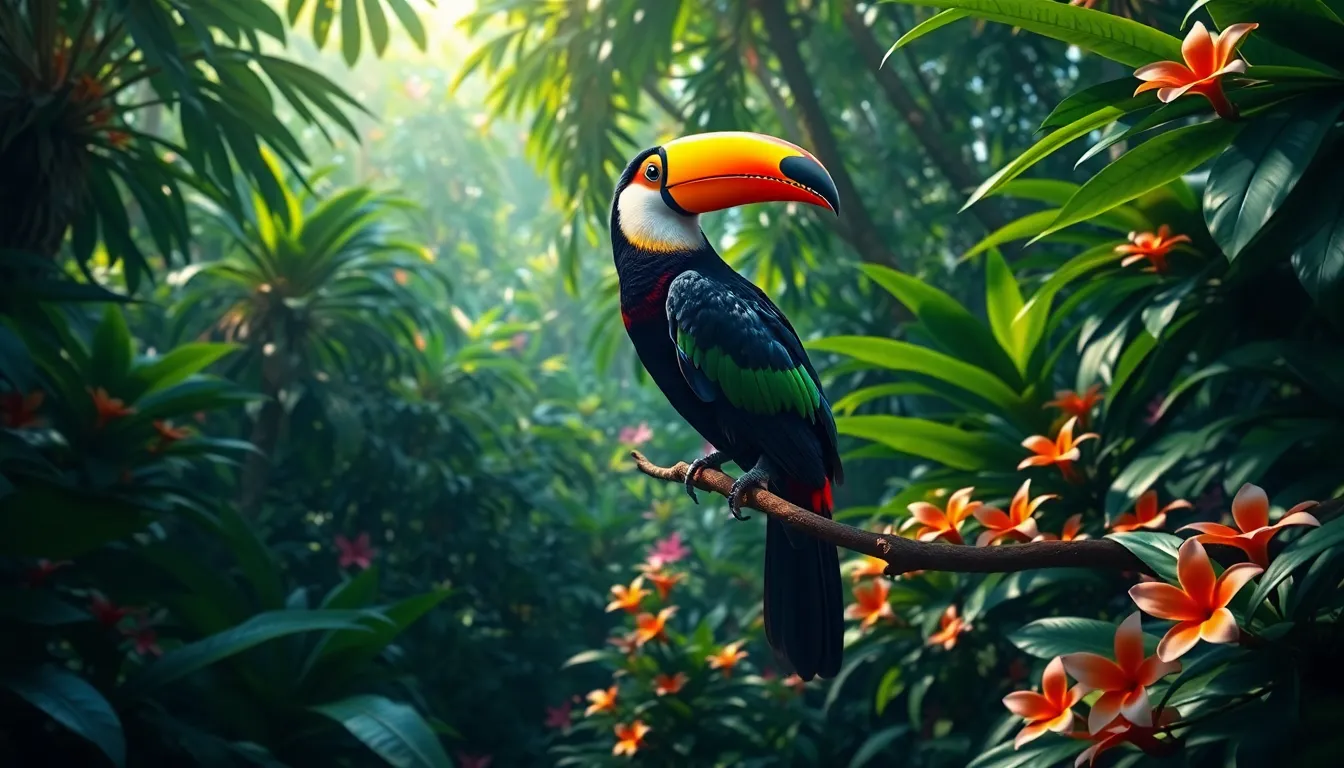
Toucans inhabit the lush rainforests of Central and South America, where their vibrant plumage blends seamlessly with the colorful canopy environment. These remarkable birds occupy exact ecological niches that provide the resources and conditions necessary for their survival and reproduction.
Rainforest Environment
Tropical rainforests create the perfect network for toucan species, offering dense canopy layers that range from 60 to 130 feet in height. We find these birds primarily in the emergent and canopy layers, where temperatures remain consistently between 70 to 85°F throughout the year. Humidity levels in their habitat stay above 80%, creating the moist conditions that support the diverse fruit trees toucans depend on for sustenance.
Epiphytes like bromeliads and orchids provide additional foraging opportunities, while the complex branch structures offer secure nesting sites in tree cavities. Dense vegetation provides protection from predators and harsh weather conditions. Multi-layered forest structures allow toucans to move efficiently between feeding areas without descending to ground level.
Primary rainforests support the highest toucan populations due to their mature fruit-bearing trees and established ecosystems. Secondary growth forests can sustain smaller populations, though they typically offer fewer nesting opportunities and reduced food diversity.
Geographic Range
Central America hosts 8 toucan species across countries including Costa Rica, Panama, Guatemala, and Belize. Mexico’s southern regions contain the northernmost toucan populations, specifically in the states of Chiapas and Oaxaca. Caribbean coastal rainforests from Honduras to Panama provide habitat corridors that connect toucan populations.
South America contains 32 toucan species distributed across the Amazon Basin and Atlantic Forest regions. Brazil supports the largest toucan diversity with 29 species, followed by Peru with 18 species and Colombia with 17 species. The Amazon rainforest spans 6.7 million square kilometers and provides habitat for 85% of all toucan species.
| Country | Number of Species | Primary Regions |
|---|---|---|
| Brazil | 29 | Amazon Basin, Atlantic Forest |
| Peru | 18 | Amazon lowlands, Andean foothills |
| Colombia | 17 | Amazon, Chocó, Magdalena Valley |
| Ecuador | 16 | Amazon, Cloud forests |
| Venezuela | 12 | Guiana Highlands, Orinoco Basin |
Altitude preferences vary among species, with most toucans living between sea level and 3,000 feet elevation. Cloud forest species like the Plate-billed Mountain-Toucan inhabit elevations up to 7,200 feet in the Andes Mountains. Lowland species dominate river basins and coastal plains where fruit abundance peaks during exact seasonal cycles.
Diet and Feeding Behavior

Toucans consume an omnivorous diet consisting primarily of fruits supplemented with insects, small reptiles, and eggs. Their specialized beaks enable precise foraging techniques that maximize nutritional intake throughout the rainforest canopy layers.
Fruit-Based Diet
Toucans derive 85% of their nutritional requirements from tropical fruits found across rainforest ecosystems. They consume over 100 different fruit species including figs, berries, palm fruits, and citrus varieties that ripen at various times throughout the year.
Primary Fruit Sources:
| Fruit Type | Percentage of Diet | Seasonal Availability |
|---|---|---|
| Figs | 35% | Year-round |
| Palm fruits | 25% | Dry season |
| Berries | 15% | Wet season |
| Citrus fruits | 10% | Variable |
Toucans prefer fruits with high sugar content and soft flesh that their beaks can easily penetrate. They swallow small fruits whole and strip larger fruits by removing flesh in small pieces using precise beak movements.
During fruit-scarce periods, toucans supplement their diet with protein sources including insects, bird eggs, small lizards, and nestlings from other bird species. This opportunistic feeding behavior ensures survival when preferred fruits become unavailable.
Feeding Techniques and Preferences
Toucans employ distinctive foraging strategies that leverage their exceptional beak dexterity and lightweight body structure. They reach fruits at branch tips that cannot support heavier birds by extending their long beaks up to 8 inches from their perching position.
Feeding Behaviors:
- Hanging upside down to access fruits on lower branches
- Using beak tips to probe crevices for hidden insects
- Tossing small fruits into the air before swallowing
- Collaborating in small groups to access clustered fruit sources
Toucans feed most actively during early morning hours between 6 AM and 10 AM when fruit sugars reach peak concentration levels. They consume an average of 12 to 20 different fruit types daily, with individual birds showing preferences for exact fruit textures and flavors.
Their feeding territory typically spans 25 to 50 acres of rainforest canopy, with established routes connecting productive fruit trees. Toucans remember seasonal fruiting patterns and adjust their daily foraging paths accordingly to maximize energy efficiency.
Toucan Bird Behavior and Social Structure
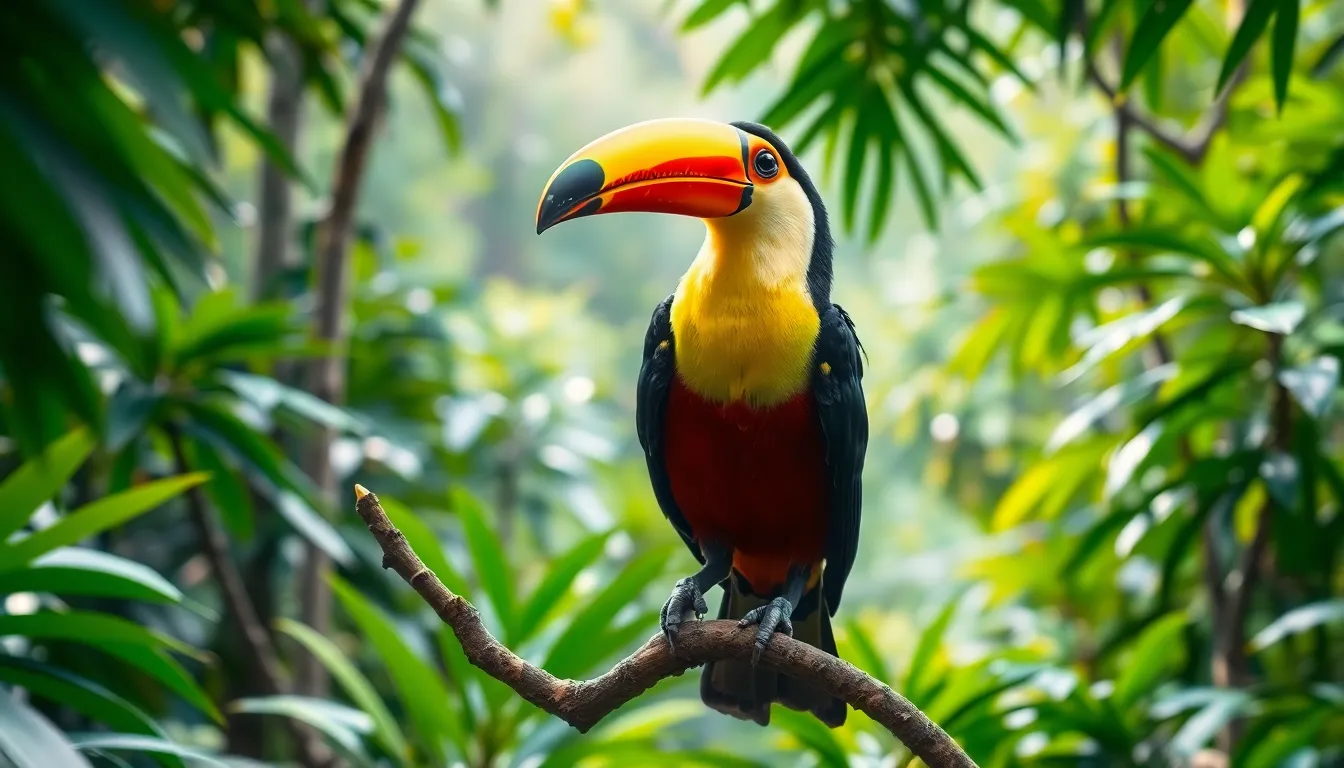
Toucan bird behavior showcases complex social interactions and communication patterns that enable these colorful creatures to thrive in dense rainforest environments. We observe fascinating reproductive strategies and vocal exchanges that strengthen their community bonds.
Mating and Reproduction
Toucan birds engage in elaborate courtship rituals that begin during the dry season from December to May. Males attract females by offering fruit gifts, tossing food items back and forth in a playful exchange that demonstrates their foraging abilities. This fruit tossing behavior serves as both courtship display and practical assessment of mate quality.
Breeding pairs establish monogamous relationships that typically last for one breeding season, though some pairs reunite in subsequent years. Toucans select nesting sites in natural tree cavities or abandoned woodpecker holes, preferring locations 20 to 60 feet above ground level. Females lay 2 to 4 glossy white eggs that both parents incubate for 16 to 20 days.
Chick rearing becomes a cooperative effort between both parents, who alternate feeding duties throughout the 6 to 7 week fledgling period. Young toucans develop their characteristic beaks gradually, reaching adult proportions by 4 months of age. Parents continue providing food and protection for several weeks after fledglings leave the nest cavity.
Communication and Vocalizations
Toucans produce diverse vocal sounds that serve multiple communication functions within their social groups. We identify over 15 distinct call types including territorial croaks, alarm calls, and contact sounds that maintain group cohesion in dense forest canopies. Their most recognizable calls carry distances up to 0.5 miles through thick vegetation.
Morning chorus activities begin before dawn as toucan pairs and family groups coordinate their daily foraging routes through synchronized calling. These vocalizations establish territorial boundaries and signal fruit tree locations to other community members. Dominant calls include deep croaking sounds, high pitched yelps, and rapid clicking sequences that vary by species.
Body language complements vocal communication through exact postures and movements that convey social messages. Toucans display aggression by pointing their beaks upward and spreading their wings, while submission involves lowering their heads and tucking beaks against their chests. Preening behaviors between pairs strengthens bonding relationships and maintains feather condition essential for flight performance.
Group dynamics involve 6 to 12 individuals who roost together in tree cavities during nighttime hours. These communal roosting arrangements provide protection from predators and help maintain body temperature during cooler periods. Toucans arrange themselves in exact positions within cavities, with dominant individuals claiming the safest interior spaces.
Conservation Status and Threats
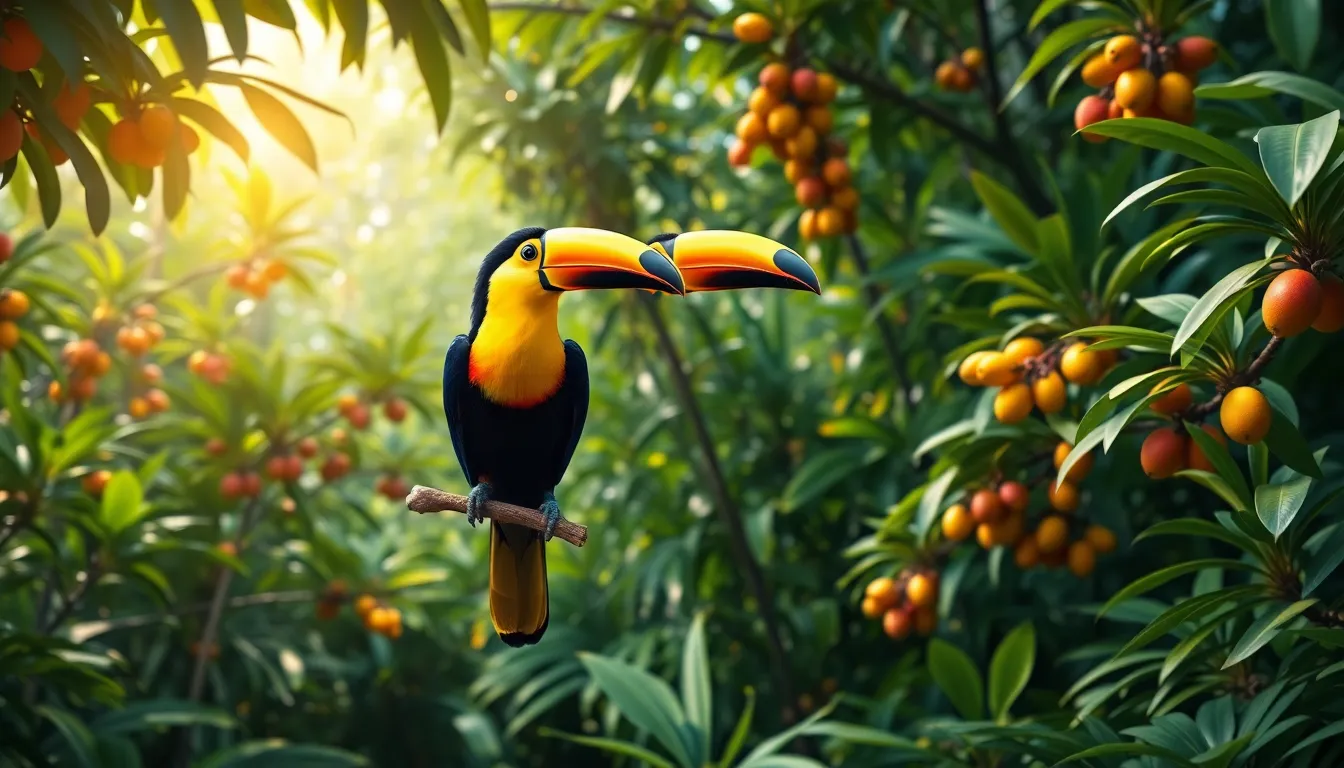
Toucan populations face mounting pressure from human activities that fragment their rainforest ecosystems. Current conservation assessments reveal varying threat levels across the 40 toucan species, with several experiencing important population declines.
Environmental Challenges
Deforestation remains the primary threat to toucan survival, destroying approximately 17 million acres of Amazon rainforest annually. Logging operations target the large trees that toucans depend on for nesting cavities, reducing available breeding sites by 60% in heavily impacted regions. Agricultural expansion converts pristine rainforest into cattle ranches and soy plantations, eliminating the fruit trees that provide 85% of toucan nutrition.
Climate change compounds these habitat pressures by altering precipitation patterns and temperature ranges across Central and South American rainforests. Rising temperatures force mountain dwelling species like the Plate-billed Mountain Toucan to migrate to higher elevations, where suitable habitat becomes increasingly scarce above 7,200 feet. Irregular rainfall disrupts fruiting cycles of over 100 plant species that toucans rely on for sustenance.
Urban development fragments continuous forest corridors into isolated patches, preventing toucans from accessing diverse foraging areas during seasonal fruit shortages. Palm oil plantations replace native forests in Costa Rica and Colombia, eliminating the palm fruits that constitute a major portion of toucan diets. Mining operations contaminate water sources and create noise pollution that disrupts toucan communication patterns and breeding behaviors.
Illegal wildlife trade targets toucans for their vibrant plumage and distinctive beaks, with smugglers capturing approximately 3,000 individuals annually across their range. Pet trade demand particularly affects Toco Toucans and Keel-billed Toucans due to their striking appearance and recognition from popular media representations.
Protection Efforts
International conservation organizations collaborate with local governments to establish protected reserves covering 12.3 million acres of critical toucan habitat across 15 countries. Brazil’s National Institute for Space Research monitors deforestation rates using satellite technology, enabling rapid response to illegal logging activities in toucan territories. Costa Rica’s Payment for Network Services program compensates landowners for maintaining forest cover, protecting 2.4 million acres of toucan habitat.
Research institutions conduct long-term population studies to track breeding success and migration patterns of threatened species like the Yellow-browed Toucanet. Scientists use GPS tracking devices and acoustic monitoring systems to gather behavioral data that informs habitat management strategies. Captive breeding programs at 23 zoological facilities maintain genetic diversity for vulnerable populations while supporting field conservation efforts.
Community-based conservation initiatives engage indigenous peoples and local communities in toucan protection activities. Ecotourism programs generate sustainable income for rural communities while creating economic incentives to preserve intact forests. Educational outreach reaches 50,000 students annually through school programs that highlight toucan ecological importance and conservation needs.
Wildlife rehabilitation centers treat injured toucans and prepare captive birds for release back into protected habitats. Anti-trafficking enforcement efforts coordinate between CITES authorities and customs agencies to intercept illegal shipments and prosecute wildlife smugglers. Habitat restoration projects replant native fruit trees and create wildlife corridors connecting fragmented forest patches.
Toucan Birds in Captivity and as Pets
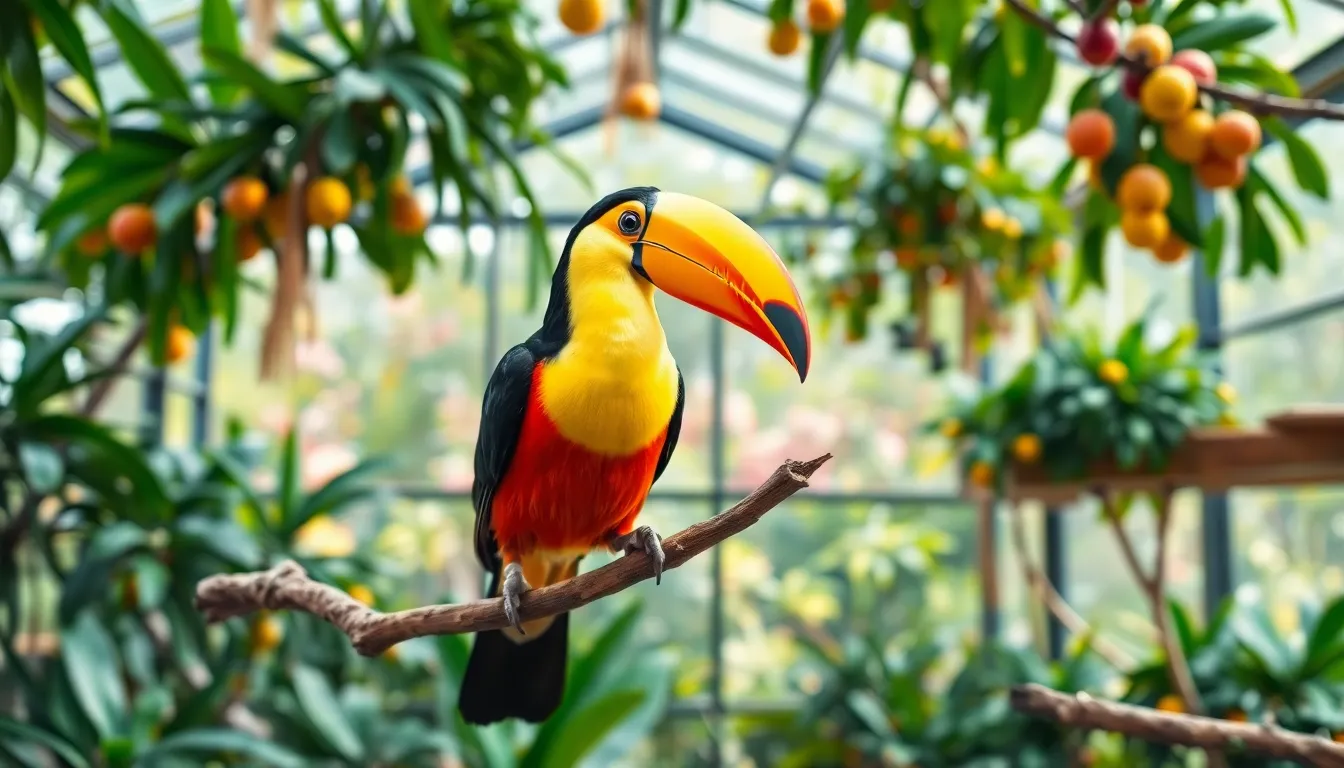
Toucan birds present important challenges when kept in captivity and aren’t suitable pets for most people. We observe complex care requirements and legal restrictions that make toucan ownership impractical for typical pet enthusiasts.
Care Requirements
Toucan birds in captivity require specialized diets that mirror their natural omnivorous feeding patterns. We provide them with 15 to 20 different fruit varieties daily, including papaya, mango, grapes and figs to replicate their wild consumption of over 100 fruit species. Their diet consists of 85% fresh fruits supplemented with high-quality pellets, insects like crickets and mealworms, and occasional protein sources such as pinky mice.
Housing needs for captive toucans demand large flight aviaries measuring at least 30 feet long by 15 feet wide by 20 feet high. We construct these enclosures with mesh spacing of 1 inch or smaller to prevent injury and escape. Temperature control maintains environments between 70°F and 80°F with humidity levels of 60% to 80%, replicating their rainforest habitat conditions.
Veterinary care requires specialists familiar with exotic bird medicine since toucans suffer from iron storage disease and other metabolic conditions. We monitor their health through regular blood tests every 6 months and provide enrichment activities like foraging puzzles and climbing structures. Daily interaction time spans 4 to 6 hours as these social birds develop behavioral problems without adequate stimulation.
Environmental requirements include multiple perching options at different heights and nesting boxes placed 12 to 15 feet above ground. We install full-spectrum UV lighting for 10 to 12 hours daily to support their calcium absorption and overall health. Fresh water sources need daily cleaning since toucans frequently bathe and drink throughout the day.
Legal Considerations
CITES regulations classify most toucan species under Appendix II, requiring permits for international transport and commercial trade. We obtain proper documentation through the U.S. Fish and Wildlife Service before acquiring any toucan species. Import permits cost between $100 and $300 per bird, plus additional quarantine fees of $500 to $1,000.
State licensing varies significantly across the United States, with some states prohibiting toucan ownership entirely. California, New York and Hawaii ban private toucan possession, while Texas and Florida require exotic animal permits costing $50 to $200 annually. We check local municipality ordinances since city regulations often override state permissions for exotic bird ownership.
Federal oversight includes USDA Animal Welfare Act compliance for commercial facilities housing toucans. Licensed exhibitors pay annual fees of $75 to $750 depending on their classification and inspection requirements. Breeding operations require additional permits and record keeping for all birds, including detailed health records and transfer documentation.
Professional facilities like zoos and research institutions operate under different regulations than private owners. We observe that accredited facilities participate in Species Survival Plans coordinated by the Association of Zoos and Aquariums. These programs monitor genetic diversity and breeding recommendations for captive toucan populations across North American institutions.
Conclusion
We’ve explored the remarkable industry of toucans and discovered why these vibrant rainforest inhabitants capture our imagination so completely. Their extraordinary adaptations – from temperature-regulating beaks to acrobatic sleeping positions – showcase nature’s incredible ingenuity in tropical environments.
Understanding toucans means appreciating the delicate balance of rainforest ecosystems and recognizing our role in protecting these magnificent birds. As deforestation and climate change threaten their habitats we’re reminded that conservation efforts aren’t just about saving individual species but preserving entire ecological networks.
Whether you’re drawn to their stunning appearance complex social behaviors or remarkable survival strategies toucans represent the beauty and fragility of our natural industry. They remind us that every creature has evolved perfect answers for their environment – and that we must act as stewards to ensure future generations can witness these living masterpieces in their native rainforest homes.
Frequently Asked Questions
What makes toucans unique compared to other birds?
Toucans are distinguished by their oversized, colorful beaks that can comprise up to one-third of their body length. These lightweight beaks have a honeycomb interior structure that helps regulate body temperature and allows precise food handling. Their zygodactyl feet (two toes forward, two backward) provide exceptional gripping strength, and their vibrant plumage patterns make them easily recognizable among rainforest birds.
How many species of toucans exist?
There are 40 distinct toucan species found across Central and South American rainforests. Each species has adapted to specific environmental conditions, resulting in variations in size, coloration, and beak patterns. Popular species include the large Toco Toucan with its iconic orange beak and the Keel-billed Toucan known for its rainbow-colored beak.
Where do toucans live in the wild?
Toucans inhabit the lush rainforests of Central and South America, from Mexico to Argentina. They thrive in tropical rainforests with dense canopy layers, consistent temperatures, and high humidity. Most species live between sea level and 3,000 feet elevation, though some mountain species like the Plate-billed Mountain-Toucan can be found up to 7,200 feet in the Andes Mountains.
What do toucans eat?
Toucans are omnivorous but derive 85% of their nutrition from over 100 tropical fruit species, including figs, palm fruits, and berries. They prefer high-sugar fruits and supplement their diet with insects, small reptiles, and eggs. Their specialized beaks allow them to access fruits that other birds cannot reach, making them highly efficient foragers.
Are toucans social birds?
Yes, toucans are highly social creatures with complex communication patterns. They use over 15 distinct call types for various social functions and engage in elaborate courtship rituals involving fruit-giving. Toucans form monogamous breeding pairs, roost together in groups for protection, and coordinate foraging activities through vocalizations and body language.
Can toucans be kept as pets?
Toucans are not suitable pets for most people due to complex care requirements and legal restrictions. They need specialized diets, large aviaries with specific temperature and humidity controls, and regular veterinary care from exotic bird specialists. Many states prohibit toucan ownership entirely, while others require special permits for keeping these birds.
What threatens toucan populations?
Toucans face significant threats from deforestation due to logging and agricultural expansion, which destroys their nesting sites and food sources. Climate change disrupts fruiting cycles and alters habitat conditions. Urban development and illegal wildlife trade also pose risks, particularly for visually striking species like Toco and Keel-billed Toucans.
How do conservation efforts help protect toucans?
Conservation efforts include establishing protected reserves, monitoring deforestation rates, and implementing community-based initiatives. Research institutions conduct long-term population studies, while wildlife rehabilitation centers treat injured birds. Educational outreach programs raise awareness and engage local communities in sustainable practices to preserve toucan habitats.
How do toucans regulate their body temperature with their large beaks?
Toucan beaks contain an extensive network of blood vessels that help regulate body temperature through heat exchange. When it’s hot, blood flows to the beak’s surface to release excess heat. When it’s cool, blood flow decreases to conserve body heat. This adaptation is crucial for maintaining optimal body temperature in tropical climates.
What is the size range of different toucan species?
Toucan species vary significantly in size, with body lengths ranging from 12 to 24 inches and weights up to 1.5 pounds. Smaller species like the Lettered Aracari measure around 12 inches, while larger species like the Toco Toucan can reach 24 inches in length. Their compact bodies make them excellent perchers despite their large beaks.

